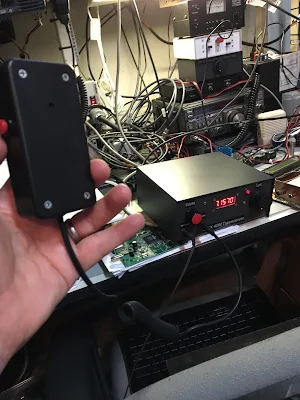In early December Steve Murphy N8NM picked up this "mystery box" at a hamfest. Dr. Juliano identified it as an old CB VFO. Even though Steve is deeply committed to the dark side of frequency generation (digital synthesis) I was able to convince him to put this VFO to legitimate and proper amateur radio use AS AN ANALOG VFO. I mean just look at that dial! It would be a sin to connect that beautiful mechanism to a rotary encoder. We see the results below.
Bill:
The 30m rig that I had hoped to have QRV for SKN is finally ready to hit the airwaves! I still have a few odds and ends to tidy up, but it's essentially done.
Where I ran into problems was my original choice of IF and VFO frequencies: I'd gone with a 13.51 MHz IF because I had the rocks, but that put the 3rd harmonic of the VFO right in the middle of the band. Oops.
Moving the IF to 13.56 fixed that problem, but I still had a spur from that harmonic that needed to be filtered. At first, it looked like a trap on the output of the VFO would squish it, but it ended up requiring a few extra poles of bandpass filtering to get it below -40 dB/c. Now we're legal.
Anyway, here's a few pics. The chassis are bent from 22 ga aluminum on my trusty Harbor Freight brake. They're almost square, they look cockeyed because I still need to make brackets to hold the top and bottom together. The heat sink is overkill for 5 watts, but it was cheap :-)
Electronically, almost everything between the audio and power amps is straight-up Bitx. The power amp uses a RD16HHF1 driven by my spin on Farhan's RF-386, and the audio is an LM380 driven by an LM324, with gating between CW and digital mode input handled by a CD4066. The CW tone generator is based on WB0RIO's "clickless" sidetone circuit, which, while a little complicated, creates perfectly formed CW elements that really sound nice.
I'm still amazed at the stability of the LC VFO; I was monitoring JT65 signals over the weekend and noticed zero drift after warm-up. To keep it ready to rock, it's powered from the "hot" side of the on/off switch, as is the CW oscillator.
I can't think of much else to say about it... It is what it is :-)
73 - Steve N8NM



















































